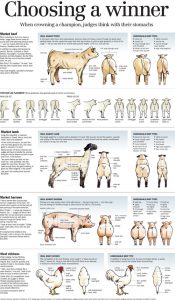Judging activities provide youth with an excellent opportunity to develop communication. It also teaches them decision making and organizational skills, and enhances their confidence and self esteem. The 4-H Animal Science Program provides an opportunity for young people to practice a variety of life skills while learning subject matter. ( This year, Lafayette 4-H had a team of 4 participate and win second place in the Livestock Judging Competition at the Suwannee County Fair. )
Florida 4-H Livestock Judging can be a very rewarding and educational experience. So often, potential leaders will not become involved because they hear they lack knowledge, qualifications or experience that they need to work with youth in this area. However, some of the most effective and successful judging programs are organized by leaders who have very little subject matter background. Animal science commands a priority within the total Florida 4-H education curriculum. An investment in young people’s knowledge, understanding and attitudes about animals affects their lives and cannot be ignored now or in the future.
What is Livestock Judging?
Livestock judging consists of carefully analyzing animals and measuring them against a standard that is commonly accepted as being ideal. It has also been defined as a study of the relationship between the animals’ form and function.
Age or Grade Levels
Developed for youth ages 11-18. Both group and individual activities encourage participation and action in all aspects of animal science livestock judging education. Youth that are involved can then build upon the skills developed by participating in this activity.
The Ideal Animal
 Animals are ranked on their value, with the ideal animal having optimum value. Animals with more positive traits are placed above those with more negative traits. There is an ideal market animal for each meat-animal species and an ideal breeding animal for both genders of each species.
Animals are ranked on their value, with the ideal animal having optimum value. Animals with more positive traits are placed above those with more negative traits. There is an ideal market animal for each meat-animal species and an ideal breeding animal for both genders of each species.
- Ideal Market Animal
- Utilize as little feed resources as possible and should generate a carcass deemed desirable relative to the current market conditions.
- Consumer preference and production practices change over time, so ideals will change as well.
- Ideal Breeding Animal:
- Displays the performance, type and reproductive sounds which should allow it to efficiently produce offspring as replacement or market animals.
- Animals of different purebred breeds have different genetic strengths and weaknesses, thus the traits of ideal breeding animals differ between breeds.
Animal Body Parts
All animal body parts have a specific function and are in some way necessary for the daily survival of that animal. Parts include: locomotion, support, sensory, reproduction and digestion. Each part is equally and separately important. Adequate knowledge of live animal body parts is essential to the evaluation of livestock and participation in the livestock industry. It is very important to know the terminology of parts and species.
Different Breeds
 A breed is defined as a group of animals with a common origin which are distinguished by characteristics within a species. Breed character is defined as the characteristics that allow the breed of the individual animal to be easily determined. Like humans, all animals have a genetic make-up. In livestock, it is easy to categorize groups based on their breed and gender characteristics. It is very important to be able to distinguish among the types, breeds and genders.
A breed is defined as a group of animals with a common origin which are distinguished by characteristics within a species. Breed character is defined as the characteristics that allow the breed of the individual animal to be easily determined. Like humans, all animals have a genetic make-up. In livestock, it is easy to categorize groups based on their breed and gender characteristics. It is very important to be able to distinguish among the types, breeds and genders.
Market Value
The value of any slaughter animal is based upon its on-farm growth and endpoint carcass merit. For the most part, livestock industry sales are weight based. The industry has weight and quality criteria that determine market value, such as the quality of the meat products produced and the amount of red meat yield generated from an animal.
Visual Appraisal
 The process of visual appraisal and selection involves the weighing of good and bad points of the individual animal. The emphasis which is placed on each characteristic in visual selection depends on species, breed, gender, and use. In many instances, more than one trait will be of top priority and you will have to weigh the relative worth of each trait in that animal.
The process of visual appraisal and selection involves the weighing of good and bad points of the individual animal. The emphasis which is placed on each characteristic in visual selection depends on species, breed, gender, and use. In many instances, more than one trait will be of top priority and you will have to weigh the relative worth of each trait in that animal.
There is more to Livestock Judging than just what appears in this post. If would you like full detail of Livestock Judging or how you can get involved in 4-H and the different clubs and curriculums they offer, contact your local Extension Office Agent.
Chris Vann- Extension Agent- Agriculture/4-H
 0
0
